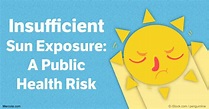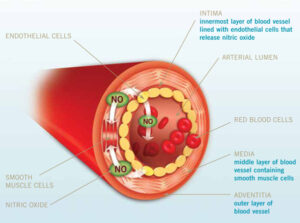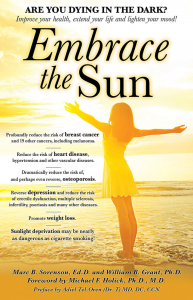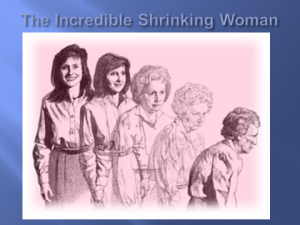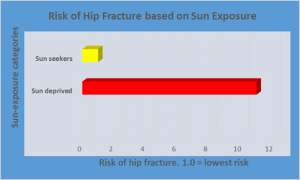Sunlight and Cancer. By Marc Sorenson, Ed.D

Sunlight and cancer are subjects that are misunderstood by most of the populace, and the press. Furthermore, sunlight and cancer are believed by most to have a cause and effect relationship. Thus, sunlight exposure to humans is thought to be dangerous and deadly, and is deemed carcinogenic by many health organizations. Yet, the research continues to indicate that sunlight and cancer have an entirely different relationship than the pundits propose. Let’s examine and comment on important sunlight and cancer research that belies the idea that more sun equals more cancer.
An impressive recent study on the protective influence of sunlight on cancer.
First of all, consider this sunlight and cancer association: sun exposure’s association to gastrointestinal cancers (esophagus, stomach, and colon). A sunlight and cancer from Iran study shows a strong negative correlation between sun exposure and the risk of these cancers.[1] A strong negative correlation means that these cancers are profoundly decreased due to sunlight. And, a salient point of this research was that for each increment of sun exposure increase, there was a corresponding drop in the risk of cancer. As regards sunlight and cancer, then, it is probably not a great idea to excessively limit sun exposure. This research, therefore may cause many people to alter their misconceptions regarding the sunlight and cancer relationship.
Another notable indication that sunlight and cancer work in opposition: more sunlight, less breast cancer.
Because of the sunlight and cancer relationship just established, we would expect more confirming research. Probably the most jaw-dropping study showed that women who were always covered had 10 times the risk of breast cancer. That is, compared to women who were out and about in the sun.[2]
More on sunlight and cancer, particularly exposure to sunlight among young girls
Also, another investigation regarding sunlight and cancer showed and interesting relationship. The influence of sunlight on breast cancer may start early in life. It is most noteworthy that girls who had the greatest sun exposure during the ages of 10-19 were strongly protected against breast cancer. And due to their sun habits, they had a 35% decrease in the risk of breast cancer as adults, compared to those who had the least sun exposure.[3] So, what do you think now about sunlight and cancer?
The sunlight and cancer relationship as regards prostate cancer
Another group of researchers used childhood sunburn as a measure of sun exposure. They determined that men who had the most sunburns as children had one-fifth the risk of contracting prostate cancer as those who had fewer sunburns![4] Also realize I am not advocating sunburns to prevent prostate cancer. Sunburns were used as a way to measure sun exposure and another measurement would have worked as well to show the sunlight and cancer relationship.
Finally, there are approximately 18 major cancers that have a negative correlation with sunlight. Read about all of them in the book, Embrace the Sun. Also, be sure to follow my blogs at sunlightinstitute.org.
Enjoy your regular, non-burning sun exposure.
[1] Najafi E, Khanjani N, Ghotbi MR, Masinaei Nejad ME. The association of gastrointestinal cancers (esophagus, stomach, and colon) with solar ultraviolet radiation.
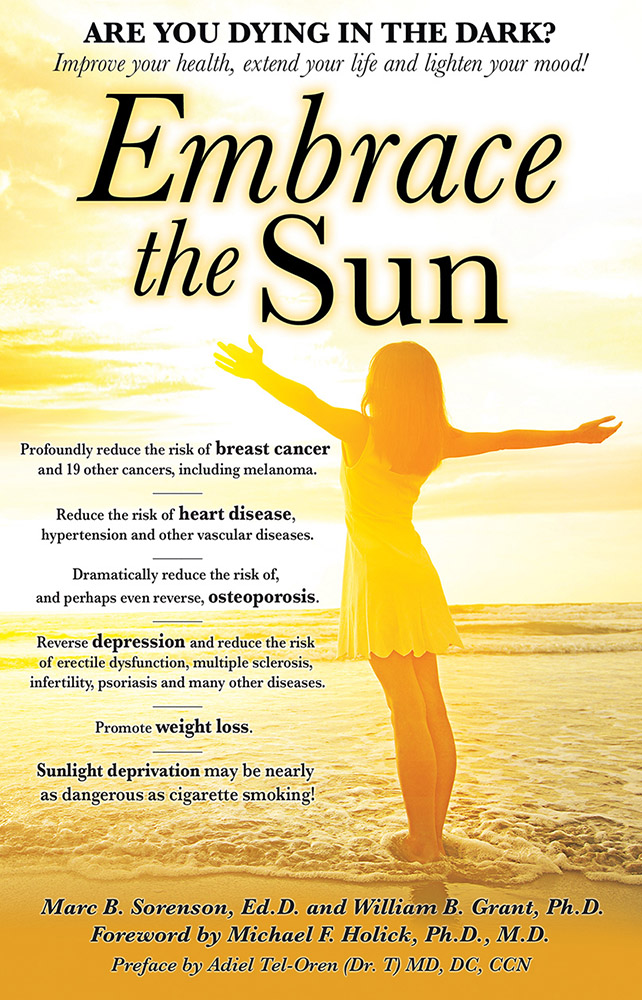
[2] Bidgoli SA, Azarshab H. Role of vitamin D deficiency and lack of sun exposure in the incidence of premenopausal breast cancer: a case control study in Sabzevar, Iran. Asian Pac J Cancer Prev. 2014;15(8):3391-6.
[3] Knight JA, Lesosky M, Barnett H, Raboud JM, Vieth R. Vitamin D and reduced risk of breast cancer: a population-based case-control study. Cancer Epidemiol Biomarkers Prev 2007;16(3):422-9.
[4] Moon SJ, Fryer AA, Strange RC. Ultraviolet radiation: effects on risks of prostate cancer and other internal cancers. Mutat Res 2005;571(1-2):207-19.
 What is blue light?
What is blue light?
Blue light is a light spectrum, emitted by the sun. It also emitted by technology devices and therefore has fallen into disrepute. First of all, blue light in the evening (typical with TV/Computer/Cellular phones) is not healthful. It is especially relevant that it inhibits melatonin, which is needed for sound sleep.[1] [2] Hence, we are warned about the deleterious effects of using our phone, tablets, TVs and computer late at night.
Is blue light both good and bad?
In addition, melatonin has anti-cancer properties.[3] However, while blue light exposure reduces evening melatonin (bad), it also inhibits melatonin production during the day (good). Why? Because melatonin lets the body relax and sleep. That is the last thing we want by day, because we should be alert and working. Blue light, while reducing melatonin at night, is wonderful by day. Another positive effect is its ability to call T-cells (important immune-system cells) into play.[4] And of course, T-cells are soldiers that can destroy noxious, invading microorganisms.
What more can blue light do?
In addition, full–body exposure to blue light decreases blood pressure, lessens arterial stiffness, and improves endothelial function.[5]
Another attribute is its ability to cause subdermal fat tissue to decrease in size.[6] In other words, it can cause fat loss. Thus, the action of sunlight may help one to stay slim or become slim. The researchers showed that daily exposure of fat cells to blue light resulted in decreased lipid droplet size and increased fat breakdown rate. The researchers had been doing research on light and diabetes, and they serendipitously found that the light could be an asset in maintaining (or producing) a slim body.
Set your circadian rhythm.
Blue light also helps to reset the circadian rhythm of the body.[7] In conclusion, remember that blue light, which is particularly beneficial during the daytime, is disruptive at night and inhibits melatonin, needed for sleep. Therefore, get out in the early morning and get your share of blue light throughout the day. And when it becomes dark, go to bed early and avoid blue light. Avoid sunburn when you are soaking up the sun. Simply cover up when you have had enough, and avoid sunscreens, which have been shown to actually increase sunburning.
Learn more!
To learn all the facts about the healthful effects of sunlight, read my book, Embrace the Sun, available at Amazon. https://www.amazon.com/Embrace-Sun-Marc-B-Sorenson/dp/069207600X 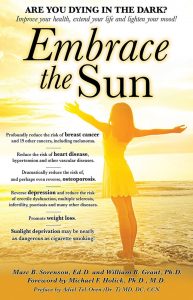
[1] Vandewalle G, Collignon O, Hull J.T, Daneault V, Albouy G, Lepore F, et al. Blue light stimulates cognitive brain activity in visually blind individuals. J Cogn Neurosci. 2013 Dec;25(12):2072.
[2] Knufinke M, Fittkau-Koch L, Møst EIS, Kompier MAJ, Nieuwenhuys A. Restricting short-wavelength light in the evening to improve sleep in recreational athletes – A pilot study. Eur J Sport Sci. 2018 Nov 14:1-8. [Epub ahead of print].
[3] de Almeida Chuffa LG, Seiva FRF, Cucielo MS, Silveira HS, Reiter RJ, Lupi LA. Mitochondrial functions and melatonin: a tour of the reproductive cancers. Cell Mol Life Sci. 2018 Nov 14 [Epub ahead of print].
[4] Phan TX, Jaruga B, Pingle SC, Bandyopadhyay BC, Ahern GP. Intrinsic Photosensitivity Enhances Motility of T Lymphocytes. Sci Rep. 2016 Dec 20;6:39479.
[5] Stern M, Broja M, Sansone R, Gröne M, Skene SS, Liebmann J. et al.
[6] Ondrusova K, Fatehi M, Barr A, Czarnecka Z, Long W, et al.. Subcutaneous white adipocytes express a light sensitive signaling pathway mediated via a melanopsin/TRPC channel axis. Scientific Reports 2017 November 27;7:16332.
[7] Bonmati-Carrion MA, Arguelles-Prieto R, Martinez-Madrid MJ, Reiter R, Hardeland R, Rol MA, Madrid JA. Protecting the melatonin rhythm through circadian healthy light exposure. Int J Mol Sci. 2014 Dec 17;15(12):23448-500.
The circadian rhythm is a variation in physiology and behavior persistent with a cycle length close to 24 hours, and regular sun exposure and dark exposure are is necessary to keep the cycle intact.[1] The circadian cycle in humans is approximately 24-hours in length and must be reset on a daily basis in order to remain in synchronization with the external environment. Sun exposure at the correct times of day is exceptionally important to human health, and when the cycle is disrupted by lack of light, such as that experienced by shift workers, or by those who live constantly indoors, it leads to a feeling of being “out of sync.” Disruption of the circadian rhythm may lead to increased breast-and/or-colorectal cancer risk in women,[2] [3] and research has demonstrated that disruption of circadian rhythms may lead to a profound increase in the risk of heart disease, metabolic syndrome, lung cancer[4] and other cancers.[5] [6]
According to the Journal Sleep Health, morning daylight exposure helps to reset the circadian rhythm or properly maintain it, which leads to better sleep at night.[7] The authors and researchers used a specialized device to measure the type of light that keeps the circadian rhythm of the human body properly set. By comparing workers in different buildings for sleep quality, they determined that those who received higher levels of morning light had considerably better sleep quality. They stated this conclusion: “The present study is the first to measure personal light exposures in office workers using a calibrated device that measures circadian-effective light and relate those light measures to mood, stress, and sleep. The study’s results underscore the importance of daytime light exposures for sleep health.” See also this link: http://sunlightinstitute.org/sleep-quality-is-improved-by-exposure-to-nature-and-sunlight/
Insomnia is a terrible problem in our modern life. To a great extent, that problem could be solved by arising early and taking advantage of an hour of morning sun exposure.
Safely enjoy your sun exposure, sleep tight and improve your health!
[1] Jeanne F. Duffy, M.B.A., Ph.D. and Charles A. Czeisler, Ph.D., M.D. Effect of Light on Human Circadian Physiology. Sleep Med Clin. 2009 Jun; 4(2): 165–177.
[2] Davis S, Mirick DK. Circadian disruption, shift work and the risk of cancer: a summary of the evidence and studies in Seattle. Cancer Causes Control 2006;17:539-45.
[3] Reparto di ChirurgiaGenerale A/D, PoliclinicoSant’Andrea, Sapienza Università di Roma. [Night work as a possible risk factor for breast cancer in nurses. Correlation between the onset of tumors and alterations in blood melatonin levels]. Prof Inferm. 2007;60:89-93
[4] Papagiannakopoulos T, Bauer MR, Davidson SM, Heimann M, Subbaraj L, Bhutkar A, Bartlebaugh J, Vander Heiden MG, Jacks T. Circadian Rhythm Disruption Promotes Lung Tumorigenesis. Cell Metab. 2016 Jul26;(16)30312-2016.07.001.
[5] Vignesh Shanmugam, Amro Wafi, Nawaf Al-Taweel and Dietrich Büsselberg. Disruptions of circadian rhythm
Increase the risk of cancer, metabolic syndrome and cardiovascular disease. Journal of Local and Global Health Science, 2013:3.
[6] Bratsun DA, Merkuriev DV, Zakharov AP, Pismen LM. Multiscale modeling of tumor growth induced by circadian rhythm disruption in epithelial tissue. J Biol Phys. 2015 Aug 21. [Epub ahead of print]
[7] Mariana G. Figueiro, Bryan Steverson, MA, Judith Heerwagen, PhD, Kevin Kampschroer, MA, Claudia M. Hunter, PhD, Kassandra Gonzales, MS, Barbara Plitnick, RN, Mark S. Rea, PhD. The impact of daytime light exposures on sleep and mood in office workers. Sleep Health June 2017;3:204-215.
Sun exposure and health… by Dr. Marc Sorenson, Sunlight Institute…
Lack of vitamin D, which is produced by sun exposure, leads to rickets, osteoporosis, osteomalacia and other bone diseases. In addition, research well after the first discovery of vitamin D has shown that vitamin D deficiency and sunlight deprivation also lead to many cancers, heart disease and multiple additional maladies. Now, as the world has modernized, the population is moving indoors, and even in the areas that are sunny throughout the year, sunlight exposure and vitamin D deficiency is increasing, both in rural and urban populations. The bones become so weakened without regular sun exposure, that the slightest movement may cause a fracture. As an example, the mother of an acquaintance of mine—a woman who avoided the sun—turned over in bed one night and broke her hip. Osteoporosis often destroys all quality or life for those who suffer it.
The importance of the sun in maintaining and producing strong bones has been known since antiquity. Dr. Richard Hobday, author of The Healing Sun, writes the following comments along with a history in an online article.[1] “Traditionally, sunlight deprivation has been linked with weak or brittle bones. One of the earliest references to this was made more than two thousand years ago by the Greek historian Herodotus (480-425 BC), who noted a marked difference between the remains of the Egyptian and Persian casualties at the site of battle of Pelusium which took place in 525 BC:
‘At the place where this battle was fought I saw a very odd thing, which the natives had told me about. The bones still lay there, those of the Persian dead separate from those of the Egyptian, just as they were originally divided, and I noticed that the skulls of the Persians were so thin that the merest touch with a pebble will pierce them, but those of the Egyptians, on the other hand, are so tough that it is hardly possible to break them with a blow from a stone. I was told, very credibly, that the reason was that the Egyptians shave their heads from childhood, so that the bone of the skull is indurated by the action of the sun — this is why they hardly ever go bald, baldness being rarer in Egypt than anywhere else. This, then, explains the thickness of their skulls; and the thinness of the Persian’s skulls rests upon a similar principle: namely that they have always worn felt skull -caps, to guard their heads from the sun.’
Herodotus, ‘The Histories’”
And here is a perhaps the transcendent study on hip fracture and sun exposure: research in Spain showed that women who were sun seekers had only about one-eleventh the risk of hip fracture as those who stayed indoors[2] (See the chart below).
That is very powerful evidence of the efficacy of sun in preventing weak bones. In stark contrast to this research are studies done on women who completely avoid the sun and suffer from osteomalacia. Osteomalacia is a soft-bone disease known as adult rickets, resulting from severe vitamin D deficiency, which deficiency prevents bone from properly mineralizing. Women who seldom go outdoors, or who are nearly always fully covered with clothing, have an extremely high incidence of osteomalacia at a very young age, even if they live in geographical areas with abundant sunlight.[3] [4] If one is never exposed to the available sun, the sun will not be able to produce its beneficial effects on the body, so one may as well live at the North Pole.
Sunbed use also is associated with stronger bones and higher vitamin D levels. An excellent study compared 50 people who used sunbeds regularly with 106 who did not.[5] The sunbed group had 90% higher vitamin D, significantly higher bone density and lower PTH levels (high PTH levels are associated with lower bone mass). The users had healthful vitamin D levels of 46 ng/ml [115 nmol/L] compared to only 24 ng/ml [60 nmol/L] for those who did not regularly use sunbeds.
Scientists at one time believed that sunlight and vitamin D were good only for preventing rickets, osteoporosis and other bone weaknesses. That belief has been supplanted by myriad research studies that show the efficacy of both sun exposure and vitamin D repletion on protection against numerous additional diseases. Nevertheless, we should never forget the extraordinary, never-changing value of sun exposure to maintaining a strong skeleton well into old age.
[1]Richard Hobday. The Healing sun: Sunlight, Brittle Bones, and Osteoporosis. http://sunlightenment.com/the-healing-sun-sunlight-brittle-bones-and-osteoporosis/. (accessed February 5, 2016)
[2] Larrosa M, Casado E, Gómez A, Moreno M, Berlanga E, Ramón J, Gratacós J. Vitamin D deficiency and related factors in patients with osteoporotic hip fracture. Med Clin (BARC) 2008;130:6-9.
[3] Sahibzada AS, Khan MS, Javed M. Presentation of osteomalacia in Kohistani women. J Ayub Med Coll Abbottabad 2004;16:63-5
[4] Al-Jurayyan NA, El-Desouki ME, Al-Herbish AS, Al-Mazyad AS, Al-Qhtani MM. Nutritional rickets and osteomalacia in school children and adolescents. Saudi Med J 2002;23:182-85.
[5] Tangpricha V, Turner A, Spina C, Decastro S, Chen TC, Holick MF. Tanning is associated with optimal vitamin D status (serum 25-hydroxyvitamin D concentration) and higher bone mineral density. Am J Clin Nutr. 2004 Dec;80(6):1645-9.
By Marc Sorenson, EdD, for sun exposure…
A new research paper on sun exposure and cancer has some interesting observations and some errors.[1] It is entitled, Does Sunlight protect us from cancer? Here is the abstract of the article, verbatim.
“The Ultraviolet (UV) radiation contained in sunlight is a powerful mutagen and immune suppressant which partly explains why exposure to solar UV is the biggest risk factor for the development of cutaneous tumors. Evidence is building that sunlight may be protective against some internal malignancies. Because patients with these tumors are often vitamin D deficient, this has led some to propose that vitamin D supplementation will be beneficial in the treatment of these cancers. However, the results from already completed trials have been disappointing which has given weight to the argument that there must be something else about sunlight that explains its cancer-protecting properties.”
The first sentence, of course, is false. The idea, that sun exposure is the biggest risk factor for skin cancer, is erroneous. We have presented materials many times, proving that melanoma is not caused by sun exposure, and that sun exposure is protective against that disease. And as regards common skin cancers, we have shown that high-fat nutrition, lack of antioxidants, meat consumption and alcohol intake are all risk factors. Search the blogs on this site to read the different articles.
The statement is correct, of course, that sunlight is protective against many internal cancers. Dr. Bill Grant and I are finishing our book, Embrace the Sun, where we present nearly all of the research on the protective influence of sun exposure against cancer.
The statement that vitamin D research has been disappointing is both true and false. Randomized controlled studies (RCTs) have shown the vitamin D supplements do have a protective effect against internal cancers, contrary to the statement by the researchers.
Finally, let’s look at the statement that there is something beyond vitamin D that explains the cancer-protecting properties of sun exposure. That is partially true. Beyond vitamin D, the sun causes the production of nitric oxide, serotonin, endorphin and BDNF, all of which are vital to human health, and may have their own cancer-protective properties.
The bottom line? Eat correctly (avoid junk), REGULARLY soak up some sun around midday and get plenty of exercise. That advice will be a boon to your health in myriad ways.
By Marc Sorenson, EdD. Sunlight Institute…
A 2016 paper in the British Journal of Dermatology showed that NMSC (also known as common skin cancer) had a positive association with cancers such as breast cancer, lung cancer and lymphoma.[1] Since NMSC is also associated with increased sun exposure, one might be inclined to say that these cancers are caused by such exposure. This is troubling, as many research papers have showed a reduced risk of most internal cancer with greater sun exposure. For example, breast cancer was the second type of cancer for which an inverse correlation between mortality rates and sun exposure was identified in the United States.[2] And, when assessing sun-exposure habits in a study of 5,000 women, scientists determined that those who lived in the sunniest areas, and who also had the highest sun exposure, had a 33% reduction in breast cancer rates compared to those who had the least exposure.[3] A subsequent study by the same group found “that a high sun exposure index was associated with reduced risk of advanced breast cancer among women with light skin pigmentation.”[4] The reduced risk was 47%. Numerous additional studies have demonstrated a reduction of the risk breast cancer among women who are regularly exposed to the sun. A discussion or these studies will me available in the book, Embrace the Sun, which should be available before the end of the 2016.
As for lung cancer, a geographical study in China demonstrated that lung cancer mortality showed a strong inverse correlation of risk with sun exposure, with an estimated 12% fall per each 10 milliwatts per meter squared per nanometer (a measurement of sun intensity) increase in UVB irradiance (sun exposure) even if adjusted for smoking.[5]
Now let’s consider lymphoma. The most recent research shows that there is an inverse correlation between Hodgkin lymphoma (HL) and the highest vs. lowest lifetime, childhood and adulthood factors: sun exposure, sun-lamp exposure, and sunburn. [1] The pooled analysis showed an odds ratio of .56, or in other words, a 44% reduced risk of contracting the disease.[6] Two items particularly stand out in this research: (1) Sun-lamp use correlated to a reduced risk of the disease—a positive result for the much maligned tanning industry—and (2) sunburn also correlated to a reduced risk. Of course, no one would recommend sun-burning—it simply serves a surrogate measurement for a high degree of sun exposure. Sun exposure can easily be used in high quantities—without burning—by moving out of the sun when the skin begins to redden, and then coming back later, after the skin has adjusted and started to tan.
Therefore, there is an interesting dichotomy between the idea that sun exposure may contribute to the three mentioned cancers, and the fact that all of these cancers have been shown to associate with low sun exposure, and be protected against by higher sun exposure.
So what is the answer? Dr. Bill Grant has found it. When people contract NMSC, they are advised to avoid the sun, thus setting themselves up for increased cancer risk.[7] Thanks again to Dr. Grant for his immediate solution to this dilemma.
There is more than sufficient research to show conclusively that most major cancers are prevented by plenty of sun exposure. Don’t be misled. Be sure to obtain some safe sun exposure whenever possible.
[1] Ransohoff KJ, Stefanick ML, Li S, et al. Association of non-melanoma skin cancer with second non-cutaneous malignancy in the Women’s Health Initiative. Br J Dermatol. 2016 May 26. [Epub ahead of print]
[2] Garland FC, Garland CF, Gorham ED, Young JF. Geographic variation in breast cancer mortality in the United States: a hypothesis involving exposure to solar radiation. Prev Med. 1990 Nov;19(6):614-22.
[3] John EM, Schwartz GG, Dreon DM, Koo J. Vitamin D and breast cancer risk: The HANES 1 epidemiologic follow-up study, 1971-1975 to 1992. Cancer Epidemiology Biomarkers and Prevention 1999;8:399-406.
[4] John EM, Schwartz GG, Koo J, Wang W, Ingles SA. Sun exposure, vitamin D receptor gene polymorphisms, and breast cancer risk in a multiethnic population. Am J Epidemiol. 2007 Dec 15;166(12):1409-19.
[5] Chen W, Clements M, Rahman B, Zhang S, Qiao Y, Armstrong BK. Relationship between cancer mortality/incidence and ambient ultraviolet B irradiance in China. Cancer Causes Control. 2010 Oct;21(10):1701-9.
[6] Monnereau A, Glaser SL, Schupp CW, Ekström Smedby K, de Sanjosé S, Kane E, Melbye M, Forétova L, Maynadié M, Staines A, Becker N, Nieters et al. Exposure to UV radiation and risk of Hodgkin lymphoma: a pooled analysis. Blood 2013;122(20):3492-9.
[7] Grant WB. Increased risk of non-cutaneous malignancy after diagnosis of non-melanoma skin cancer may be due to sun avoidance. Br J Dermatol. 2016 Jul 15. [Epub ahead of print].
By Marc Sorenson, EdD. Sunlight Institute…
Canada has a long season each year in which vitamin D from sunlight is not available. Due to the northern latitude of Canada, May through October is the only period when vitamin D can be produced in response to sun exposure to the skin. Therefore, a new press release from the Vitamin D Society recommends to protect health by building up vitamin D during the summer. Vitamin D from the summer sun helps to prevent serious diseases such as cancer, cardiovascular diseases, diabetes, multiple sclerosis and others.
Dr. Reinhold Vieth, the scientific advisor for the Society, states the following: We often assume that the health benefits of sunshine are solely due to vitamin D, but that is not proven yet. In other words, it is likely that sunshine does more for our bodies than just produce vitamin D.”
Dr. Vieth is correct. Vitamin D is only one of several products of sun exposure. Others are nitric oxide, which helps prevent vascular problems, and serotonin and endorphins that enhance mood. It is likely that there are many more products of sun exposure that enhance human health.
The Society recommends 6 guidelines for safely enjoying the sun and its health benefits:
- Be moderate, and don’t burn.
- Sun exposure can produce vitamin D only during the mid-day hours, so be outside between 10 AM and 4 PM.
- Know your skin type and risk of burning. Red hair and very light skin predict a greater risk of burning. (Also remember that dark skin needs more sun exposure to produce vitamin D).
- A gradual build-up of a tan protects the skin from burning.
- When the skin begins to redden, it is time to stop the sun exposure.
- Frequent but shorter sun exposure times are better for producing vitamin D.
Since about 35% of all Canadians do not meet suggested vitamin D requirements, sun exposure is essential to reverse that statistic.
So Canadians, safely enjoy the sun this summer!
To read the entire press release, go to this link: http://www.vitamindsociety.org/press_release.php?id=44
By Marc Sorenson, EdD. Sunlight Institute….
While reading one of Dr. Michael Holick’s latest publications,[1] I was intrigued that he quoted from a book published in 1915 called The Mortality from Cancer throughout the World.[2] That book stated that indoor workers had 8 times the risk of dying of cancer compared to outdoor workers. Would this old study make you want to avoid sun exposure? Not unless you have a death wish!
Then, in 1937 Dr. Sigismund Peller determined that deadly internal cancers were 40% less common among people who spent long hours in the sun.[3] A few years later Dr. Frank Apperley did research that demonstrated the following: North American death rates for major cancers among the inhabitants of cities between 30˚ and 40˚ north latitude were 85% higher than death rates among inhabitants of cities between 10˚ and 30˚; inhabitants of cities between 40˚ and 50˚ north latitude had cancer death rates 118% higher than those between 10˚ and 30˚; inhabitants between 50˚ and 60˚ had death rates from internal cancers 150% higher than those between 10˚ and 30˚.[4]
There have been myriad studies in modern times, and one of the most compelling demonstrated that among women who totally covered themselves and thereby had no sun exposure, there was a more than a 10-times increase in the risk of the breast cancer.[5] Stated in another way, that is a 1,000% increase in risk due to sun deficiency.
Do you think it is about time that we decided that sunlight is good for us? Just be sure not to burn.
[1] Holick, M. Biological Effects of Sunlight, Ultraviolet Radiation, Visible Light, Infrared Radiation and Vitamin D for Health. Anticancer Research 36: 1345-1356 (2016).
[2] Hoffman F The mortality from cancer throughout the world, Newark, N.J., The Prudential Press, 1915.
[3] Peller S. Carcinogenesis as a means of reducing cancer mortality. Lancet 1936; 2:552-56.
[4] Apperley, F. The relation of solar radiation to cancer mortality in North America. Cancer Res 1941;1:191-95.
[5] Bidgoli SA, Azarshab H. Role of vitamin D deficiency and lack of sun exposure in the incidence of premenopausal breast cancer: a case control study in Sabzevar, Iran. Asian Pac J Cancer Prev. 2014;15(8):3391-6.
By Marc Sorenson, EdD, Sunlight Institute…
A study from China demonstrates that residents who have the lowest sun exposure also have the highest risk of death.[1] The study obtained overall death rates and incidence rates from cancers per se from a national database during the years from 1998 to 2002) They compared those death rates to the quantity of sun intensity in the areas (263 counties) in which the residents lived.
The results were telling: Overall death risk for all cancers combined, and specifically for cancers of the esophagus, stomach, colon, rectum, liver, lung, breast and bladder were inversely correlated with increasing sun exposure. Lung cancer showed the greatest protection provided by sun exposure, with a 12% decrease in death risk for every 10 mW/(nm m2) increase in UVB irradiance (a measure of intensity of sun exposure).
Incidence rates of several cancers were also inversely correlated to sun exposure, namely cancers of the esophagus, stomach, colon, rectum and cervix. Only nasopharyngeal cancer and cervical cancer increased with sun exposure. The authors suggested the possibility that vitamin D provided the mechanism by which the overall cancer rates were reduced.
Dr. William Grant has confirmed that there are many cancers that correlate to low sun exposure and/or low vitamin D levels,[2] and there are dozens more diseases beyond cancer that have an inverse relationship with sun exposure. Dr. Grant and I will soon release a book that will delve into all of the diseases that sun exposure helps to prevent. Please world, let us back in the sun without making us feel guilty!
[1] Chen W, Clements M, Rahman B, Zhang S, Qiao Y, Armstrong BK. Relationship between cancer mortality/incidence and ambient ultraviolet B irradiance in China. Cancer Causes Control. 2010 Oct;21(10):1701-9.
[2] William B. Grant. Role of solar UVB irradiance and smoking in cancer as inferred from cancer incidence rates by occupation in Nordic countries. Dermato-Endocrinology 4:2, 203–211; April/May/June 2012.

